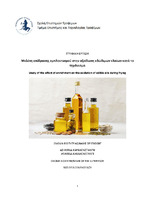| dc.contributor.advisor | Σινάνογλου, Βασιλεία | |
| dc.contributor.author | Καρακωνσταντή, Ασημίνα | |
| dc.date.accessioned | 2024-10-16T08:32:17Z | |
| dc.date.available | 2024-10-16T08:32:17Z | |
| dc.date.issued | 2024-09-30 | |
| dc.identifier.uri | https://polynoe.lib.uniwa.gr/xmlui/handle/11400/7756 | |
| dc.identifier.uri | http://dx.doi.org/10.26265/polynoe-7588 | |
| dc.description.abstract | Σε αυτή τη μελέτη, εμπλουτίστηκαν δύο έλαια, το πυρηνέλαιο και το σησαμέλαιο, με τρεις διαφορετικές αντιοξειδωτικές ουσίες, το ασκορβικό οξύ, το γαλλικό οξύ και τις οινολογικές ταννίνες. Αφού πραγματοποιήθηκε ο εμπλουτισμός ξεχωριστά για κάθε έλαιο και αντιοξειδωτική ουσία σε συγκεκριμένο όγκο δείγματος, αυτές οι ποσότητες ξεχωριστά τοποθετήθηκαν σε τηγάνι και πραγματοποιήθηκε η διαδικασία τηγανίσματος. Ανά τακτά χρονικά διαστήματα, 0min, 5min, 10min, 15min, 20min, 30min και 35min, συλλεγόντουσαν υποδείγματα, ώστε στη συνέχεια, να πραγματοποιηθούν αναλύσεις για τον αριθμό υπεροξειδίων και της τιμής p-ανισιδίνης, οι οποίοι είναι δείκτες της οξείδωσης των ελαίων, με τη βοήθεια του CDR FOODLAB TOUCH. Με αυτό το τρόπο, τα αποτελέσματα που διεξήχθησαν, έδειξαν για το κάθε δείγμα ξεχωριστά, την οξειδωτική αντίσταση των εμπλουστισμένων και μη ελαίων στην θερμική επεξεργασία του τηγανίσματος. Ύστερα, έγινε σύγκριση ανάμεσα στις τιμές για κάθε δείγμα πυρηνελαίου εμπλουτισμένου και μη για κάθε χρονική στιγμή, ανάμεσα στα αποτελέσματα για κάθε δείγμα σησαμελαίου εμπλουτισμένου και μη, και, τέλος, ανάμεσα στην αντιοξειδωτική αντίσταση κάθε αντιοξειδωτικού στο διαφορετικό έλαιο. Το συμπέρασμα που βγήκε από το πείραμα αυτό, ήταν πως οι ταννίνες προσέφεραν υψηλή οξειδωτική αντίσταση κατά το τηγάνισμα, δίνοντας χαμηλές τιμές αριθμού υπεροξειδίων και p-ανισιδίνης. Το επόμενο αντιοξειδωτικό που είχε ικανοποιητικά αποτελέσματα αλλά όχι όσο οι ταννίνες, ήταν το ασκορβικό οξύ, και τέλος, το γαλλικό οξύ παρατηρήθηκε με βάση τις τιμές του πως το ίδιο αντιοξειδωτικό αυτό, επιτάχυνε την θερμική οξείδωση και στα δύο έλαια, και σε πιο έντονο βαθμό στο πυρηνέλαιο. Επομένως, για μία έντονη θερμική επεξεργασία σε αυτά τα δύο έλαια που χρησιμοποιήθηκαν στο πείραμα αυτό, προτείνεται σαν αντιοξειδωτική ουσία οι ταννίνες. | el |
| dc.format.extent | 64 | el |
| dc.language.iso | el | el |
| dc.publisher | Πανεπιστήμιο Δυτικής Αττικής | el |
| dc.rights | Αναφορά Δημιουργού - Μη Εμπορική Χρήση - Παρόμοια Διανομή 4.0 Διεθνές | * |
| dc.rights | Attribution-NonCommercial-NoDerivatives 4.0 Διεθνές | * |
| dc.rights.uri | http://creativecommons.org/licenses/by-nc-nd/4.0/ | * |
| dc.subject | Εμπλουτισμός ελαίων | el |
| dc.subject | Πυρηνέλαιο | el |
| dc.subject | Σησαμέλαιο | el |
| dc.subject | Τηγάνισμα | el |
| dc.subject | Αριθμός υπεροξειδίων | el |
| dc.subject | Π ανισιδίνη | el |
| dc.title | Μελέτη επίδρασης εμπλουτισμού στην οξείδωση εδώδιμων ελαίων κατά το τηγάνισμα | el |
| dc.title.alternative | Study of the effect of enrichment on the oxidation of edible oils during frying | el |
| dc.type | Πτυχιακή εργασία | el |
| dc.contributor.committee | Στρατή, Ειρήνη | |
| dc.contributor.committee | Τσιάκα, Θάλεια | |
| dc.contributor.faculty | Σχολή Επιστημών Τροφίμων | el |
| dc.contributor.department | Τμήμα Επιστήμης και Τεχνολογίας Τροφίμων | el |
| dc.description.abstracttranslated | In this study, two oils, olive pomace oil and sesame oil, were enriched with three different antioxidants, ascorbic acid, gallic acid and oenological tannins. After the enrichment was carried out separately for each oil and antioxidant in a certain sample volume, these quantities were separately placed in a pan and the frying process was carried out. At regular time intervals, 0min, 5min, 10min, 15min, 20min, 30min and 35min, samples were collected, so that subsequently, analyzes were carried out for the number of peroxides and the value of p-anisidine, which are indicators of the oxidation of oils, with the help of CDR FOODLAB TOUCH. In this way, the results carried out showed for each sample separately, the oxidative resistance of the enriched and non-enriched oils in the heat treatment of frying. Then, a comparison was made between the values for each enriched and non-enriched olive pomace oil sample for each time point, between the results for each enriched and non-enriched sesame oil sample, and finally, between the antioxidant resistance of each antioxidant in the different oil. The conclusion drawn from this experiment was that tannins offered high oxidative resistance during frying, giving low values of peroxide number and p-anisidine. The next antioxidant that had satisfactory results but not as much as tannins, was ascorbic acid, and finally, gallic acid was observed based on its values that this same antioxidant accelerated thermal oxidation in both oils, and to a more intense degree in the olive pomace oil. Therefore, for an intense heat treatment in these two oils used in this experiment, tannins are suggested as an antioxidant substance. | el |



